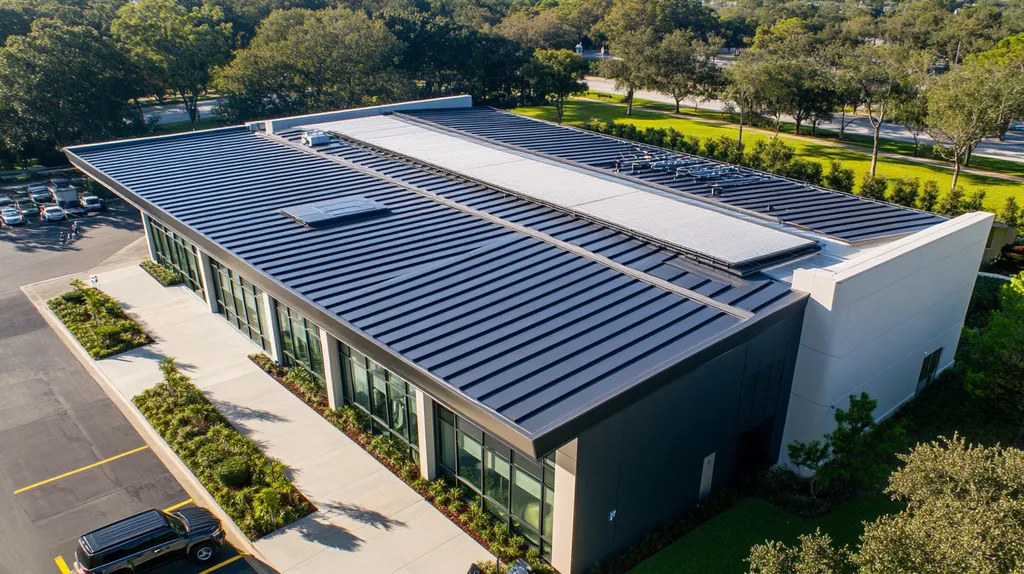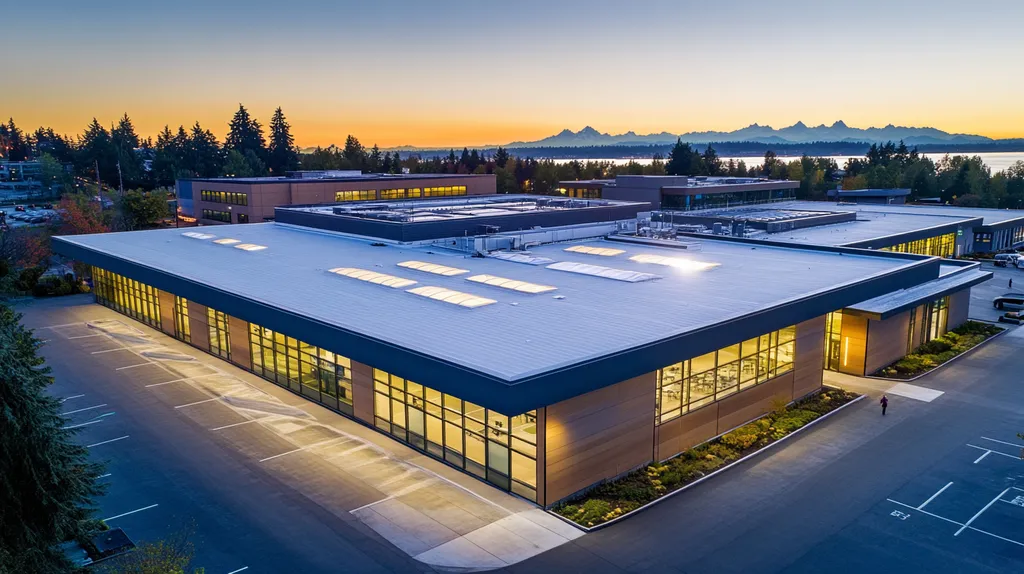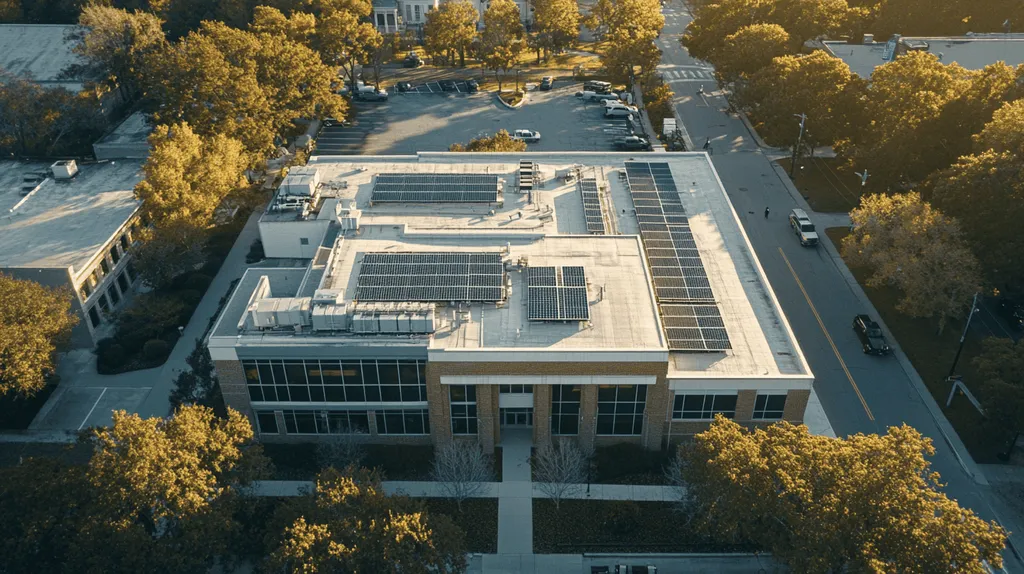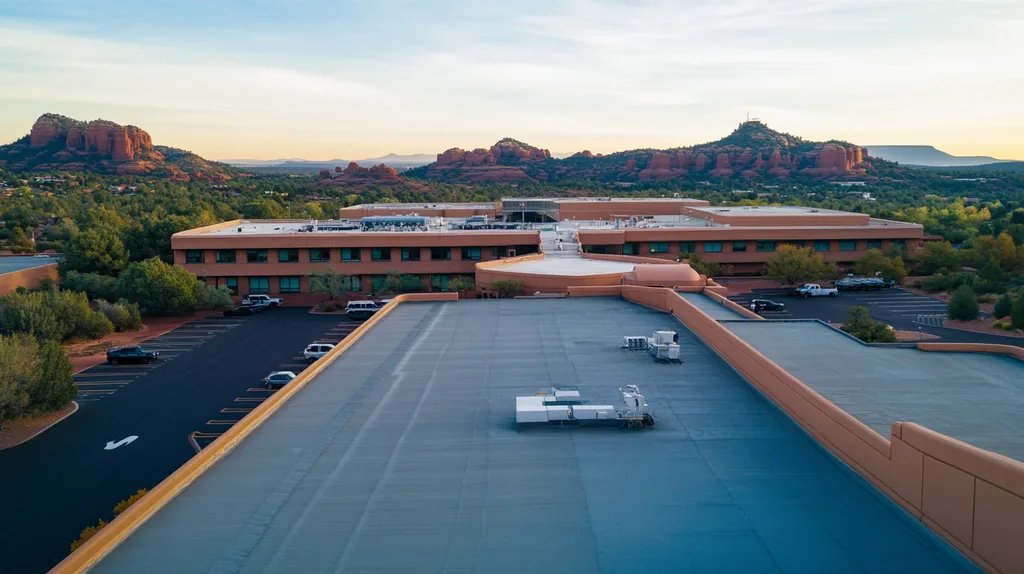Commercial roofing projects that run overtime or over budget cost U.S. businesses an estimated $3.9 billion annually in repairs, disrupted operations, and emergency fixes.
Despite these high stakes, many building owners continue to make decisions based on misconceptions about project timelines and implementation requirements.
This comprehensive guide examines the realities of commercial roof work schedules, exploring common timeline myths, practical implications of poor planning, and evidence-based solutions that protect both buildings and bottom lines.
SECTION 1: COMMON MISCONCEPTIONS
In the realm of commercial roofing, misunderstandings can result in costly mistakes and unforeseen delays. Many property managers mistakenly believe that the timelines for commercial roofs are similar to those for residential roofs, but this couldn’t be further from reality. Grasping the unique challenges of commercial roofing projects is crucial for effective planning and execution.
Residential and Commercial Roofing Are the Same
A prevalent misconception is that residential and commercial roofing projects share similar timelines. In truth, commercial roofs are generally larger, more intricate, and utilize different materials and installation techniques. For instance, while a residential roof replacement might take just a few days, a commercial roof overhaul can extend to weeks.
The stakes are considerable; hurrying through a commercial roofing job risks both quality and safety. Commercial projects must adhere to strict building codes, undergo specialized inspections, and effectively manage logistics like material delivery and equipment access.
Moreover, each type of commercial roof—be it flat, low-slope, or sloped—has unique installation processes. Different designs come with specific challenges and durations, highlighting that a one-size-fits-all approach is misguided.
By recognizing these differences, property owners can improve project scheduling and resource management. This informed approach to commercial roofing can minimize disruptions and enhance the longevity of the roof.
Commercial Roofs Can Be Installed Quickly
Another widespread misconception is the belief that commercial roofs can be installed swiftly without compromising quality. Although there have been advancements in roofing technology that streamline some processes, thorough planning and execution remain essential. For example, hasty installations can lead to substantial long-term problems.
Various factors, such as weather conditions, material availability, and project size, significantly influence timelines. If a facility manager anticipates a quick completion, they may encounter obstacles, especially if the roof system necessitates specialized materials or advanced installation techniques.
Additionally, properly preparing the substrate before installing any roofing system is critical. Skipping or rushing this foundational step can result in leaks and premature wear, counteracting any time savings achieved during installation.
Ultimately, appreciating that quality takes time is vital for property managers. By allowing ample time and thorough planning, they can achieve a durable and reliable roof.
Any Roofer Can Handle Commercial Jobs
A final misconception is the belief that any qualified roofer can effectively manage commercial roofing projects. While many roofers thrive in residential settings, commercial roofing often demands specialized knowledge. Systems like TPO or EPDM require expertise and an understanding of commercial codes and standards.
Engaging a roofer lacking experience in commercial projects can lead to inadequate workmanship and unexpected challenges. A lack of familiarity with these unique requirements can result in costly mistakes, from subpar craftsmanship to violated codes.
Moreover, commercial roofs frequently feature intricate designs and drainage systems. These complexities require a contractor well-versed in their specifics to prevent future issues. Selecting a roofer with commercial expertise is essential for ensuring a smooth installation process and optimal results.
In the end, choosing the right contractor for commercial projects is crucial for success. By recognizing that not all roofers are created equal, property owners can sidestep pitfalls and protect their investments.
SECTION 2: PRACTICAL IMPLICATIONS
The stakes in commercial roofing are incredibly high. Selecting the wrong materials can not only drain a budget but also jeopardize a facility’s operational efficiency. Inadequate project planning often leads to extended timelines and inflated costs, while overlooking local regulations can result in hefty fines and project delays. Navigating these practical implications is essential for property owners and facility managers who want both longevity and performance from their roofing systems.
Impact of Incorrect Material Choices
An improper material choice can drastically diminish a roof’s lifespan and overall effectiveness. For example, opting for low-quality membranes may yield initial savings but can lead to early failures that result in costly water damage. Such issues can disrupt normal operations and lead to lost revenue.
Often, builders select cheaper materials without assessing their suitability for local climate conditions. This oversight can exacerbate temperature regulation problems and escalate energy costs. For instance, a commercial facility located in a humid region that requires moisture-resistant materials can face severe degradation if the wrong product is utilized.
Ultimately, choosing the right materials safeguards the roof’s integrity and secures long-term financial health. Investing in quality materials can minimize future repair costs and shield facilities from weather-related damages.
In conclusion, selecting appropriate roofing materials is a significant decision with long-lasting effects. It requires balancing upfront costs with durability, avoiding short-term savings that could lead to larger failures down the road.
Consequences of Inadequate Project Planning
Inadequate project planning can trigger a domino effect of delays and added expenses. It’s all too common for roofing projects to run longer than anticipated due to a lack of foresight. Such delays can disrupt daily operations and negatively impact tenant satisfaction.
For example, poorly coordinated material deliveries can leave contractors waiting on supplies. This downtime can elongate the roofing installation timeline, resulting in increased labor costs and prolonged exposure to the elements.
Additionally, overlooking weather considerations during project planning can lead to unexpected work stoppages. Rain or extreme weather can impede progress, causing further delays and complications in scheduling.
Thorough project planning involves careful consideration of timelines, budgets, and contingency measures. Addressing these aspects upfront significantly reduces the risk of unexpected costs and disruptions later in the project.
Effects of Ignoring Local Regulations
Neglecting local regulations can have serious repercussions for roofing projects. Compliance with building codes is not merely advisable; it is a legal requirement. Failing to adhere to these codes can result in costly fines or even complete project shutdowns.
Local regulations often specify essential materials or installation practices. Noncompliance can lead not only to financial penalties but also to increased on-site injury risks or future structural issues. These complications can complicate insurance claims and escalate project costs.
Engaging with local authorities early in the project planning phase can facilitate a smoother approval process. Proactive communication helps identify necessary permits and avoid costly delays later on.
Staying informed about local regulations and codes is critical for ensuring projects remain compliant and proceed without unexpected legal complications. This awareness is a foundational element of effective project management in commercial roofing.
SECTION 3: COST OF MISINFORMATION
Misinformation about commercial roofing can lead to severe financial repercussions. With a staggering 60% of delayed roofing projects resulting in budget overruns, the stakes are high. This section will explore the costly consequences of these misconceptions, focusing on delayed project timelines, rising maintenance expenses, and the negative impact on business operations.
Financial Consequences of Delays and Repairs
Delays in roofing projects often arise from inadequate planning and miscommunication. As timelines stretch, costs can escalate quickly, with budgets increasing due to added contractor fees and rising material prices.
For instance, a roofing project designed for two weeks could extend to a month or longer because of incorrect planning. Each additional week can cost a business thousands in labor and lost productivity.
In addition to labor costs, businesses may need to invest in temporary solutions or safety measures, further increasing the financial toll of delays.
Moreover, if repairs are postponed, the resulting damage to interior structures can inflate remediation costs significantly. By establishing accurate timelines and committing to clear communication, property owners can prevent these financial pitfalls.
Increased Maintenance Costs Over Time
Misconceptions about roofing maintenance may hinder effective long-term planning and lead to skyrocketing costs. Property owners frequently underestimate the necessity of timely inspections and repairs, presenting a façade of satisfaction until major issues arise.
For example, a minor leak that goes unaddressed could result in substantial water damage and mold growth, increasing repair costs dramatically. An emergency roof replacement can end up costing three to five times more than addressing maintenance concerns early on.
Additionally, the use of subpar materials or incorrect installation techniques can necessitate more frequent repairs, amplifying expenses over time. Investing in quality workmanship from the outset can save significant amounts in the long run, reinforcing the importance of due diligence.
Implementing a proactive maintenance plan could help property owners minimize larger issues, resulting in substantial savings throughout the roof’s lifespan.
Potential Loss of Business Operations
Delays in roofing projects can seriously disrupt business operations. A functional roof is vital for the smooth operation of any commercial facility, and when work extends past the intended timeline, businesses may face unexpected shutdowns.
For example, a retail store undergoing extensive roofing repairs might have to close temporarily, resulting in lost sales and frustrated customers. The potential for substantial revenue loss grows with each day of delay.
Businesses in sectors sensitive to disruptions—such as manufacturing or food services—can endure drastic financial setbacks. A roof that does not meet compliance standards can halt production due to safety concerns or regulatory breaches.
In extreme situations, a prolonged closure could damage a company’s reputation, leading to lasting consequences beyond immediate financial loss. Understanding the significance of accurate timelines and consistent communication is crucial for maintaining business continuity and overall success.
SECTION 4: REALITY CHECK
The timeline for commercial roof work is often underestimated, which can lead to significant financial and structural risks. Rushing a project to meet a tight deadline frequently results in poor-quality installations, causing further complications down the line. Studies indicate that nearly 30% of roofing projects face delays due to unforeseen factors. It is vital for building owners to comprehend what drives these timelines to make well-informed decisions.
Factors Influencing Installation Timelines
Understanding the factors impacting installation timelines is essential for property owners. The scope of the project plays a fundamental role; larger and more intricate installations naturally require additional time. For instance, a complete roof replacement will take longer than a simple repair due to necessary structural assessments and a greater amount of materials.
The expertise of the roofing contractor also significantly affects the timeline. Experienced contractors typically work more efficiently, allowing for quicker completion with fewer mistakes. Engaging a skilled team can facilitate a more streamlined process, helping property owners adhere to their planned schedules.
Furthermore, coordination with other ongoing construction or renovation activities at the site can cause delays. If roofing work coincides with plumbing or electrical installations, it might slow down the overall project timeline. Adequate planning and open communication are key to mitigating these timing challenges.
Role of Weather and Supply Chains
Weather plays an undeniable role in disrupting roofing timelines. Rain, high winds, or extreme temperatures can halt work entirely, extending the schedule beyond what was initially planned. For example, certain roofing materials cannot be applied in temperatures below a specific threshold, leading to delays during cooler months.
In addition, the current supply chain landscape heavily influences roofing timelines. Delays in material deliveries—due to shortages or transportation issues—can stall projects significantly. Recent analysis showed that shortages in roofing materials have increased project durations by an average of 15-20%.
Property owners should proactively prepare for potential weather-related interruptions and supply chain uncertainties by building contingency time into their schedules. This forward-thinking approach can help prevent rushed work, ensuring quality is not compromised.
Importance of Inspections and Permits
Inspections and permits are vital to ensuring roofing projects proceed smoothly and in compliance with regulations. Many jurisdictions require permits for roofing work, and the time taken to secure these can extend project timelines. Failing to obtain the necessary permits can result in costly delays or even a complete halt to the project.
Inspections are equally essential; they verify that the work meets safety and building standards. The longer a project extends due to required inspections, the more expensive it can become. However, bypassing inspections can lead to future complications that could have been easily avoided.
By allocating sufficient time for inspections and permitting processes, property owners can minimize unexpected project delays. Early coordination with local authorities can streamline this essential aspect, allowing work to progress as intended.
SECTION 5: EVIDENCE-BASED ALTERNATIVES
In the commercial roofing industry, informed decision-making is vital to safeguarding investments and avoiding costly repairs. Property owners who stick to outdated materials or overlook regular inspections face significant risks. For instance, research shows that 30% of commercial roofs fail prematurely due to inadequate maintenance. By exploring evidence-based alternatives, property owners can make smarter choices that lead to lasting benefits.
Choosing the Right Roofing Materials
Selecting appropriate roofing materials can greatly affect a roof’s lifespan and performance. Options like TPO, PVC, and EPDM each bring distinct advantages tailored to various building needs. For instance, TPO is celebrated for its energy efficiency, while PVC provides exceptional durability under extreme weather conditions.
The choice of material should consider climate, architectural design, and intended use. Opting for the wrong material can not only shorten longevity but also void warranties and lead to soaring energy costs. Prioritizing quality materials offers long-term savings and improved protection for the building.
Moreover, new advancements in material science have introduced sustainable options like cool roofs and green roofs. These innovative alternatives significantly lower energy consumption while enhancing aesthetic appeal. Therefore, aligning roofing materials with performance requirements and environmental impacts is essential.
Implementing Routine Inspection Schedules
Establishing routine inspection schedules is critical to maintaining the health of commercial roofs. Regular evaluations allow property owners to identify minor problems before they snowball into costly repairs. It’s advisable that roofs are inspected at least twice a year, especially following severe weather events.
During these examinations, professionals can check for common issues like membrane tears, water pooling, and flashing failures. Early detection of these problems plays a crucial role in extending the roof’s lifespan. Additionally, routine inspections help ensure compliance with warranty and insurance requirements.
Advancements in technology, such as drone surveillance and thermal imaging, can significantly improve inspection quality. These modern techniques provide detailed visuals and data, leading to more accurate assessments. Utilizing cutting-edge inspection methods often results in better maintenance decisions and cost savings.
Following Industry Best Practices
Adhering to industry best practices is paramount for successful commercial roofing projects. Comprehensive specifications during installation ensure that roofs can effectively resist environmental stressors. This includes proper flashing details, adequate ventilation, and compliance with local building codes.
Training workers in these best practices not only enhances installation quality but also upholds safety standards. Poorly executed installations can lead to hazards like leaks and structural damage, threatening the integrity of the entire roofing system. Investing in skilled labor is essential for achieving a reliable, long-lasting roof.
Staying updated on evolving best practices and technologies in the roofing industry can yield long-term benefits. Regular participation in professional development opportunities and industry conferences allows property owners to adopt new innovations. Such commitment is vital for staying competitive and maintaining property value over time.
SECTION 6: TEST AND VERIFY
In the world of commercial roofing, ensuring quality work is non-negotiable. A botched roofing job can lead to severe issues such as leaks and structural damage, which can be expensive and disruptive. Alarmingly, studies indicate that poor roof management can decrease a building’s lifespan by as much as 30%. This section highlights essential steps for verifying contractors and materials, ensuring that each roofing project meets industry standards and best practices.
Verifying Contractor Licenses and Certifications
Choosing the right roofing contractor is pivotal to the success of any project. Ensuring that contractors possess the appropriate licenses and certifications shields property owners from unprofessional work and potential liabilities. Many states mandate specific licensing for roofing contractors, which serves as a benchmark for their skill and professionalism.
Additionally, certifications from material manufacturers ensure that contractors have received specialized training to work with specific types of roofing products. For instance, a contractor certified by a prominent roofing manufacturer will be better prepared to address warranty issues and recognize product limitations effectively.
Before entering into any contracts, property owners should request and verify proof of licenses and certifications. This simple step can save building owners from significant complications later and encourages high-quality workmanship. Thorough verification lays a solid groundwork for successful roofing projects.
Conducting Regular Roofing Inspections
Regular roofing inspections are crucial for maintaining a commercial roof’s integrity. These evaluations help identify minor issues before they escalate into costly problems. Experts recommend conducting inspections at least twice a year and after severe weather events to catch vulnerabilities early.
During these inspections, trained professionals assess critical components such as the integrity of the roof membrane, drainage systems, and wear on flashing. Catching these issues promptly not only extends the roof’s lifespan but also improves overall performance. For example, ignoring a small crack in the membrane can lead to leaks that result in significant water damage over time.
By prioritizing routine inspections, property owners can minimize long-term maintenance costs and bolster the longevity of their roofs. Implementing effective inspection strategies serves as a proactive approach to maximizing the value of roofing investments.
Evaluating Material Warranties and Performance
The materials chosen for a roofing system play a vital role in its longevity and performance. Unfortunately, many property owners overlook the importance of thoroughly reviewing material warranties, which can differ significantly among manufacturers. Understanding warranty terms helps owners know what is covered and for how long, preventing unexpected repair costs.
Performance ratings—such as resistance to wind and moisture—are also essential when selecting roofing materials. For example, a high wind uplift rating is crucial for buildings located in hurricane-prone areas. Failing to consider these aspects can result in premature roof failure and financial strain.
Engaging with knowledgeable contractors and carefully reviewing warranty documentation can help property owners make informed choices about their roofing systems. A solid grasp of both warranties and material performance ensures that building owners make wise investments, reducing risks associated with roofing maintenance.
The Bottom Line
Commercial roofing timelines represent a critical junction where proper planning meets business continuity, with industry data showing project delays costing U.S. businesses nearly $4 billion annually.
Understanding the realities of commercial roof work schedules – from material selection and contractor verification to weather considerations and regulatory compliance – directly impacts both short-term operations and long-term building integrity.
Property owners who implement evidence-based practices, maintain rigorous inspection schedules, and partner with qualified contractors consistently report fewer disruptions and lower lifetime maintenance costs.
The stakes are clear: investing time in proper planning and execution of commercial roofing projects protects not just the physical structure, but also the financial health and operational stability of the entire organization.
FREQUENTLY ASKED QUESTIONS
Q. Are commercial roof timelines the same as residential roofs?
A. No, commercial roofs typically take much longer to install. They are larger and use more complex materials and installation techniques than residential roofs. Understanding these differences is essential for effective scheduling and project management.
Q. How do material choices affect my commercial roof’s timeline?
A. Choosing the wrong materials for your commercial roof can lead to delays and failures. High-quality materials are essential for durability and compliance with local codes, while improper choices can extend project timelines and increase costs significantly.
Q. What are the costs associated with delays in commercial roofing?
A. Delays in roofing projects can lead to increased labor costs and lost productivity. Each week of extended work can cost thousands, especially if temporary measures or repairs are needed due to unresolved issues. Effective planning and communication are vital to avoid such financial pitfalls.
Q. How does weather influence commercial roofing timelines?
A. Weather can significantly affect commercial roofing timelines. Adverse conditions such as rain, high winds, or extreme temperatures can halt installation work, causing delays. Property owners should incorporate potential weather-related interruptions into their project schedules to avoid rushed work or unforeseen issues later.
Q. Why are regular inspections important for commercial roofs?
A. Regular inspections are essential for maintaining a commercial roof’s integrity and prolonging its lifespan. Inspections help identify minor issues early, preventing them from escalating into costly repairs. They also ensure compliance with warranties and building codes, thus protecting your investment.
Q. How can I verify a roofing contractor’s qualifications?
A. It’s crucial to verify that roofing contractors have the appropriate licenses and certifications. Request proof of these credentials before hiring. A qualified contractor is more likely to deliver high-quality work and adhere to safety standards, reducing the risk of future problems.
Q. What alternatives should I consider for my commercial roof?
A. Consider using innovative materials and technologies for your commercial roof, such as cool roofs or green roofs. These options can enhance energy efficiency and improve durability. Staying updated on these alternatives allows property owners to make informed decisions that benefit both their building and the environment.










